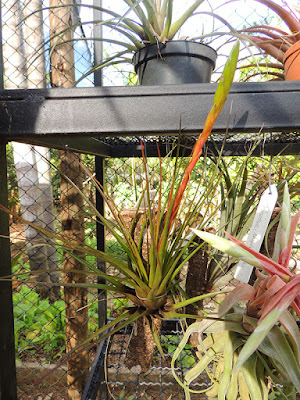Tillandsia tricolor is native to Central America (Costa Rica, Panama, Guatemala, Nicaragua, Honduras) and Mexico (Veracruz, Oaxaca, Chiapas). It grows hanging on the branches of trees at an altitude ranging from 500 to just over 2300 meters.
Tillandsia tricolor, also called as Vriesea xiphostachys, Tillandsia acroleuca, Tillandsia melanocrater, Tillandsia tricolor var. picta, Tillandsia tricolor var. melanocrater, is a species of the genus Tillandsia. This species was described by Diederich Franz Leonhard von Schlechtendal & Adelbert von Chamisso in 1832.
IDENTIFY TILLANDSIA TRICOLOR AIR PLANT
Tillandsia tricolor is native to Central America (Costa Rica, Panama, Guatemala, Nicaragua, Honduras) and Mexico (Veracruz, Oaxaca, Chiapas). It grows hanging on the branches of trees at an altitude ranging from 500 to just over 2300 meters.
It is a medium sized epiphyte, which reaching 30 cm, acaule with numerous, leathery leaves. The bright green leaves have dark brown leaf sheaths and the transition between the two has many small brown spots that dot the green leaf blade. The leaves are stiff and become red in the center at flowering time. While they are wider at the base they tapper to a fine point. The out leaves tend to all away from the main rosette in a recurved manner.
This air plant blooms from the quite large (25 cm) yellow inflorescence and exceeding leaves, simple or composed of ears, on a fine peduncle. The bracts of the flowering stem are upright, nested and green or red. The floral bracts are nested, glabrous except at the apex, leathery, green at the base and red at the apex. The flowers are sessile, tubular, 4 to 6 cm long, purple in color. The stamens and the pistil are exserts.
TILLANDSIA TRICOLOR AIR PLANT CARE AND CULTURE
Cultural information should only be used as a guide, and should be to be adapted to suit you. Your physical location; where you grow your plants, how much time you have to devote to their care, and many other factors, will need to be taken into account. Only then can you decide on the cultural methods that best suit you and your plants.
Light:
Tillandsia tricolor requires a good light and tolerates full sun (avoid the afternoon in summer if the plant is young or has not been used). Be careful in winter to return the plant after watering to empty the water that accumulates in the heart of the plant (waterproof rosette) and thus avoid any risk of rot.
Temperature:
The required temperature ranging from 10 to 32°C. Get it early enough in the fall if you grow it outside, so that it does not face night temperatures below 4 or 5 ° C, especially if it is wet. The plants can faced temperatures close to 0 ° C (sheltered and dry) for a few hours without damage. Hanging in the shade of a tree, he will enjoy the differences in temperature between day and night, and a more humid atmosphere than in apartment.
Humidity:
This air plant need the moderate level of humidity. Good aeration is important, the plant must dry quickly (in less than an hour).
Substrate, growing media and repotting:
Tillandsia tricolor refer to be mounted on a solid substrate that does not retain water (on a piece of wood for example). You can glue the plant directly to the surface with a strong adhesive, or you can wire the plant to the base. Don't cover the base of the plant with moss or it may rot. It can be grown on almost any imaginable decorative mount, including shells, rocks, slate, driftwood, etc. Group them in decorative clumps for maximum effect. Place the plant very close to a window in the winter and preferably outside the summer in sunny or partial shade.
Watering:
Twice a week in summer, once a week in winter according to the luminosity and the ambient humidity. Obviously when it rains and if you grow it outside, it counts as a watering. Be sure to return the plant after watering to remove excess water.
Fertilizer:
This air plant can be fertilized with the moderate doses. 1 to 2 times a month in the summer and 1 time a month in the winter.















COMMENTS